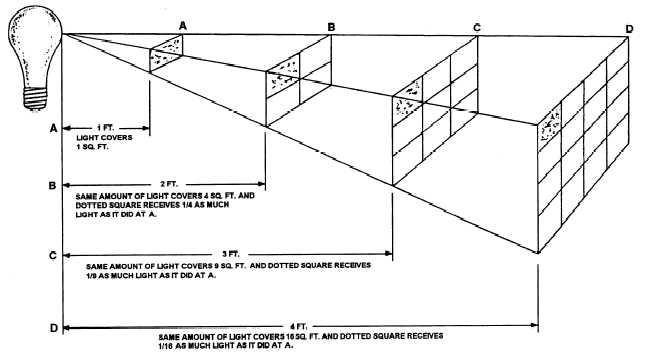Figure 11-10.—Inverse-square law.
LENS HOODS
Lens hoods, or shades, are used to keep strong
sunlight from striking the front of the lens obliquely.
PHOTOGRAPHIC LIGHTING
LEARNING OBJECTIVE: Identify the basic
theories of photographic lighting in terms of
outdoor lighting, existing light and electronic
flash lighting.
Light is the most important ingredient in
photography. Light makes photography possible by
reflecting off the subject, entering the camera and
exposing the film.
Scientists tell us that light is produced in waves. In
many respects the waves of light can be compared to
sound waves. Sound waves vary in length and they
register as different pitches; conversely, light waves
register as different colors.
The intensity of light determines the brightness of
the subject. The formula that determines this is the
inverse-square law (fig. 11- 10). It demonstrates that
light decreases as the square of the distance increases.
Becoming familiar with this law will help you use light
more effectively during photographic assignments.
The light falling upon a subject from a source is
tilled incident light. When incident light strikes a
surface, it will change direction; this change is called
reflection. If the surface is smooth, the reflected light is
said to be specular; however, if the surface is rough, the
reflected light is diffused Most objects reflect back both
types of light.
Reflection is an important characteristic of light. It
is how our eyes can see objects and how film acquires
a latent image.
In this section you will learn how to take pictures
using the following types of light:
l Outdoor
l Existing
. Electronic flash
OUTDOOR LIGHTING
Daylight and sunlight are not constant sources —
they change hourly with the weather, seasons and
latitude. The changes in daylight can radically alter the
apparent shapes, colors, tones and forms of a scene. The
color of sunlight changes most rapidly at the extreme
end of the day. Strong color changes also occur during
storms, haze or mist and on blue wintery days. The
11-11


